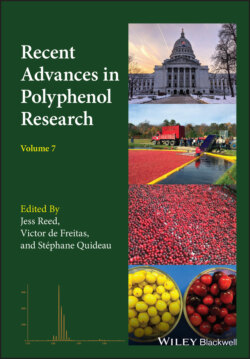Читать книгу Recent Advances in Polyphenol Research - Группа авторов - Страница 15
1.2 Flavylium Cation as a Metamorphosis Generator
ОглавлениеThe flavylium cation, AH+, is the most stable species at very low pH values, in anthocyanins generally for pH<1. The system is conveniently studied by direct pH jumps when base is added to the flavylium cation, and reverse pH jumps, defined as addition of acid to equilibrated solutions at higher pH values. After a direct pH jump to moderately acidic pHs, the flavylium cation equilibrates in microseconds with quinoidal base, A eq. (1). The next step is the formation of the hemiketal, B, through the hydration of AH+ (min) eq. (2), followed by the ring opening to form cis‐chalcone, Cc, (ms) eq. (3). The fact that the quinoidal base does not open in acidic medium is a breakthrough discovery (Brouillard and Dubois 1977) crucial for the comprehension of anthocyanins and related compounds systems. The Cc isomerization to trans‐chalcone, Ct, in anthocyanins takes place in several hours eq. (4). When the system is equilibrated in moderately acidic pH values, a reverse pH jumps restores the flavylium cation. The following set of equilibrium reactions accounts for the system:
Figure 1.1 Sketch of the metalloanthocyanin responsible for the color in Cummelina communis. The building blocks self‐associate to create the supramolecule in a bottom‐up approach.
Source: Courtesy of Prof. Kumi Yoshida.
Scheme 1.1 The metamorphosis concept in biology and in chemistry applied to anthocyanins and related compounds in acidic medium.
Source: Reproduced from Mendoza et al. (2018), with permission.
(1)
(2)
(3)
(4)
A few years ago we introduced an energy level diagram that accounts for the thermodynamic of the anthocyanin system in acidic medium (Pina et al. 1997; Pina 2014a). This diagram can be straightforwardly constructed provided that the equilibrium constants, eq. (1) to eq. (4), of the system have been determined, see Scheme 1.2.
Scheme 1.2 Energy level diagram for anthocyanins and related compounds in acidic medium.
Source: Adapted from Pina 2014a. © 2014 John Wiley & Sons.
